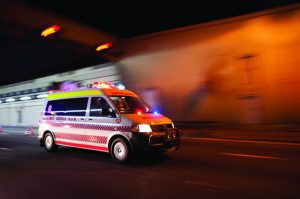![]() Tips for when you have called an ambulance – (if you need an ambulance now – Call ‘000’ immediately).
Tips for when you have called an ambulance – (if you need an ambulance now – Call ‘000’ immediately).
Let your Defibshop help you! You have dialled ‘000’ (in Australia) and requested the assistance of an ambulance paramedic crew. Think about the information you will need to give to assist the operator getting a paramedic crew to you:
Your location, including suburb, street name and number, nearest cross street and any other land marks that may assist the paramedics to locate you, and make it easier to locate the patient sooner. Thought: Can your house / block number be seen easily by any emergency crews?? Take a look, you might not be able to identify your number easily – day or night.
The operator will also require some information about the problem you are calling about. For example, is the patient in Sudden Cardiac Arrest? Are they conscious? Are they breathing normally? Do they have a pulse? Is their colour normal? Do you have a defibrillator at hand?
You will be asked what happened that has caused the problem you are calling about. For example, was it a motor vehicle crash? Did the patient fall from a ladder? Did they collapse at home?
Remember, sometimes it is a real puzzle for the attending paramedics to locate you! Take a look at these handy tips to assist the paramedics to get to the patient sooner:
- Clearly marked house / building numbers – day and night light.
- Turn on your outside lights where possible at night time.
- Have a car in the driveway? Turn on your hazard lights, and if possible, move car into the street – this allows the paramedics to quickly identify your location, and, also allows them easier access to your premises with their equipment and stretcher.
- Send someone out to wait for the arrival of the ambulance and guide them with directions. Ideally, the paramedics will look for, and use the simplest way in and out of the location.
- Remember also that most ambulance vehicles that transport patients are higher than a usual vehicle – look for barriers that may prevent the paramedics from driving as close to the scene as a normal car would. Utilise other modes of transport such as golf buggies etc if available.
- Prepare any details that will assist the paramedic, such as patient name, D.O.B, current medications, any known allergies to medications and past medical history if known. Print off our free patient details form here – Patient Details Form
- Place patients medications into a plastic bag or a container where possible and if you have time.
- If time and helping hands permit, move furniture and other items from hallways, corridors etc to make extrication of the patient easier, faster and more practical.
- Gather any medical reports, doctor, hospital or community nursing notes together that may assist the attending paramedics to better treat the patient.
- Secure your pets. We know they won’t bight you, your friends and family, but with strangers it is sometimes a lot different. Remember, you know and feed your pet dogs, but the paramedics are complete strangers to them!! Lock them (your pet dogs!) in the laundry, back yard or other safe place until the paramedics and others (such as police, welfare workers etc) have departed.
- And, the pension card! Have any benefit cards handy to go with the patient when the paramedics arrive.
Remember, the ‘000’ service is there to assist you at any time. If you have called for an ambulance, and the patients condition deteriorates, call ‘000’ again to let them know changes have occurred. ‘000’ operators are highly skilled and trained to assist you with the emergency you are experiencing – they are able to talk with you until the paramedics arrive and you have help directly at hand on scene.
Most ambulance services in Australia also have other numbers you can call if the situation is non-urgent. ‘000’ is for emergencies only, and ambulances are not taxis.
Patient Details Form Do you have a list of handy information to help your paramedic team to help you? You can print off this handy list – a freebie from your Defibshop to assist you to pass on as much information as possible to your attending paramedic team. Print off a copy and place it on your fridge door, and if you can, a copy in your wallet, purse or handbag etc. And, remember to regularly update your details.
To make contact with your local ambulance service, click here.
Can you answer this question? What do the following letters stand for when you are assessing a patient? DRSABCD. Find out by clicking on the following link and ordering your FREE DRSABCD Fridge Magnet!! FREE!!
Like to make it easier to locate your AED & First Aid gear at an event such as a sporting match or a conference venue? Then take a look at our AED flags to make it easy to locate all your emergency equipment!!
Defibshop – makes saving lives easy!
Australia’s No: 1 Defibrillator Store!


